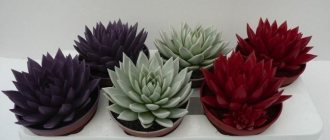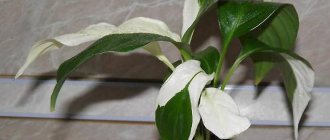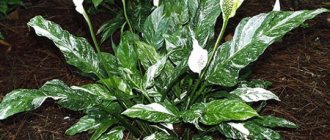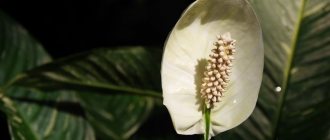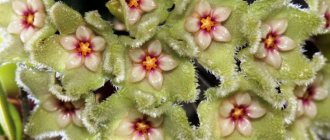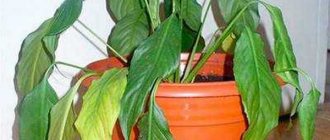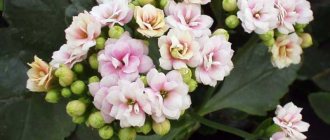Description of the spathiphyllum plant
The bush has no stems; small leaves grow directly from the roots, forming thick green tufts. The roots are quite short. Small tubercles are visible on the stem bud. These are aerial roots, characteristic of plants of the Araceae family. The leaf blade is oval-elongated, pointed, with a noticeable midrib.
What does the plant look like?
The lateral veins are also clearly visible. Small flowers form a white spadix on a long peduncle, around which on one side there is a white oval blanket with a pointed tip. The name spathiphyllum reflects the specific appearance of the flower: in Greek, “spatha” means bedspread, and “phyllum” means leaf.
The graceful flowering of spathiphyllum lasts several weeks, from mid-spring to July. Some varieties bloom from late March to early autumn. With good care, the plant also produces flowers in the fall.
If spathiphyllum does not bloom for a long time, replanting, carried out in accordance with the correct recommendations, will activate the vitality of the plant. For popular indoor culture, the dormant period begins in October and lasts until January. At this time, ensure a temperature of at least 16 ° C and infrequent watering. With high air humidity, flower stalks are created in winter.
For the successful development of spathiphyllum, the following requirements must be met:
- constant high air humidity;
- moderate watering so that the substrate is constantly slightly moist;
- abundant spraying, since the plant comes from tropical forests;
- location in an area of diffused light or artificial lighting, but not in direct sunlight;
- Northern exposure or placement on attached platforms near windows is preferable;
- comfortable temperature within 20-23 °C.
Important! If spathiphyllum is constantly in deep shade, the leaves become small.
How to properly care for a transplanted plant?
It is important to adhere to the basic rules:
- the main thing is not to overdo it in watering dosages, the drinking regime is moderate;
- the optimal place to stay is bright but diffused sunlight;
- air temperature – not less than 220C;
- air humidity is increased by wiping the leaves and spraying;
- soil – moist, loose;
- air exchange is important - the room is regularly ventilated;
- complementary feeding is carried out after 2-3 weeks;
- During the flowering period, spathiphyllum is not fertilized.
In conclusion, it should be noted that the transplant procedure is quite simple; over time, the necessary skill and dexterity is acquired. The efforts will not be in vain; within 2-3 years the green corner will turn into a small oasis of tropical exotics.
Why there is a need to transplant spathiphyllum
The plant develops well if there is sufficient space for the roots. Spathiphyllum transplantation at home is carried out in the following cases:
- the bush has just been purchased and is in a small pot;
- regularly every 3-5 years in the spring to ensure development, since the bush grows quickly and the roots intertwine, wrap around the entire substrate, and protrude to the surface;
- if the lower leaves dry out inside the bush;
- for propagation, choosing from a bunch a fragment where there is a growing point and roots.
Spathiphyllum - home care, why the tips of the leaves dry out
There is another important reason when you need to think about how to transplant spathiphyllum faster: in the absence of flowering.
Additional Information. Replanting will not be necessary if the tops of the leaves turn yellow. This is a sign that the air in the room is too dry for spathiphyllum.
When is the best time to move a plant to another pot?
Until the plant reaches three years of age, it should be replanted every spring. From the 4th year of development - should be replanted according to condition.
Indications for transplantation:
- The roots have come out of the ground and lie on the surface.
- The roots are peeking out from the drainage hole.
- The plant is sick with root rot or affected by sooty fungus.
- Pests attacked: aphids, spider mites, thrips, mealybugs.
Attention! The best time to transplant is spring, before flowering.
Post-Purchase Replanting Guide
Orchid care at home: options for propagating and planting a flower
A plant from a store is replanted after 15-25 days. The waiting time before replanting the spathiphyllum serves to adapt it to new conditions in a residential building. Temperature and light conditions change sharply for the bush. Immediate planting in a new substrate will be an unnecessary stress factor. Overgrown bushes are usually moved by transshipment, without breaking the old earthen ball.
Roots
Step-by-step actions when you need to plant a recently purchased and already acclimatized plant:
- before transplanting, the spathiphyllum in the container is watered abundantly;
- when the water is absorbed, carefully remove the plant, inspect the roots and select the used drainage;
- place the plant in a new pot on a laid drainage and a small layer of soil, if necessary, straighten the protruding shoots and sprinkle them with soil;
- the top layer of the substrate is compacted and watered;
- If the substrate settles after watering, add prepared soil.
Features of transplanting flowering spathiphyllum
It happens that a problem suddenly arises, how to plant spathiphyllum in bloom. The plant will tolerate summer movement without traumatic consequences. The following rules are adhered to:
- the substrate is watered abundantly, then after 30-40 minutes it is removed from the container;
- if the transplant is carried out due to signs of disease, inspect the roots and cut off the rotten ones with a sharp, disinfected knife, and also shorten those that are too long;
- cut off the flower stalks at the base with pruning shears so that the plant directs energy only to adaptation to the new substrate;
- remove yellowed, wilted leaves and those that have just begun to form;
- The renewed bush is placed in a pot, the substrate is added and compacted.
You can plant a large, developed spathiphyllum bush as a whole; it is better to divide it into several parts with healthy rhizomes. If transshipment is carried out without much intervention in the root system, several young flowers are left and the old ones are removed.
Peduncles
When creating comfortable conditions for spathiphyllum after transplantation, care is taken to ensure sufficient humidity. During the first 10-13 days, a frame is installed above the bush, and a plastic film is placed on top. The shelter will protect the plant from rapid evaporation of moisture.
During this period, water the substrate after the top layer becomes dry. The leaves are sprayed once a day. In the case when the leaf blades droop, spraying is increased more often, up to 2-3 times a day.
Note! When moving a plant from one container to another, the primordia of aerial roots are left on the surface. The shoots gradually increase in size and go deeper into the soil.
Questions
Some very popular questions:
What problems can you encounter after transplantation?
Some time after transplantation, the tips of the leaves of the plant may dry out and yellow spots may form. The formation of yellow-brown spots indicates overwatering. With an overdose of fertilizers, blackening of flowers may occur. If blackening is detected, the soil must be treated with a foundation solution. Dissolve 2 grams of the drug in 1 liter of water. Yellowing occurs due to improper watering or when kept in a place that is too sunny.
Important! Feature - after flowering, yellowing of the leaves is considered a normal process and does not require intervention.
If there is a lack of light, the spathiphyllum grows long, narrow leaves; it needs to be changed.
Why doesn't it bloom?
There are many reasons:
- lack of minerals;
- old age;
- lack of moisture;
- low temperature.
Why did the leaves turn black?
Again, there are several reasons:
- underfilling;
- overflow;
- lack of minerals.
What to do in this case? You take the plant out of the pot, cut off the new roots and move it into a new, pre-treated pot with new soil.
How to get rid of parasites?
Our main enemies were aphids and spider mites. In order to get rid of unwanted neighbors, you should cover the ground around the plant with a film and not allow the solution of soap and nicotine sulfate to be absorbed while you wash the leaves. The procedure needs to be carried out several times, but the parasites are no longer there.
Other pests can also cause poor growth and development:
- Sooty mushroom. The process of blackening of the leaves indicates the appearance of a fungus. It is localized on the upper leaf plate, disrupting the flower's breathing. The measure of influence is soap spraying.
- Mealyworm. Detected at high humidity. Hiding among the leaves. Inspect periodically for pests. If there are a small number of copies, you can remove them with a cotton pad soaked in an alcohol solution. An infusion of citrus peels is considered effective and is used to treat mealyworms. Take 100 grams of crusts, place in 1 liter of water, keep in a dark place for 2 days. Wipe the leaves with the resulting solution.
- Shield. Juveniles are barely visible. The appearance of dark spots on the stem and leaves indicates the presence of scale insects. A good result comes from spraying a soap-tobacco solution with the addition of denatured alcohol or kerosene. To treat a plant against aphids and spider mites, you can use an infusion of onion peels. Heat 5 liters of water to 40 degrees, soak 100 grams of husk. Keep in a dark place for 2 days, then treat the leaves.
Spathiphyllum is a very beautiful flower and, moreover, easy to care for. It can become an indispensable part of your decor - be it a simple apartment or even an office, it doesn’t matter in the slightest, it looks harmonious anywhere. However, if you do not follow the rules of care, if you ignore its needs, then “Women’s Happiness” is unlikely to be able to please you in the future with its delicate flowers.
Selection rules
Spathiphyllum chopin - description of a home flower
When planting a large spathiphyllum bush or transferring a purchased plant into a new container, pay attention to the choice of pot and soil recommended for indoor culture.
Potty
When choosing which pot is needed for spathiphyllum, determine the size of the previous one. The plant is planted in a container that exceeds the former container by 1.5-2 cm in width and height. Flower growers have noticed that spathiphyllum blooms profusely when the roots cover the entire substrate.
Trimming
In a pot that is too spacious, the bush will grow its root system and only then throw out its flower stalks. Containers with holes in the bottom through which excess water flows into the pan after watering are suitable. As with any indoor plant, spathiphyllum requires 1-2 cm of drainage.
Ground
Spathiphyllum develops well in a slightly acidic substrate, pH 5-6.5, loose and light in structure. In such soil mixtures, excess moisture seeps into the pan. The retail chain chooses a universal mixture for aroid or tropical flowering plants, which is mixed with a handful of sand. Many gardeners prepare their own substrate. You can choose the appropriate one, usually the simplest one in execution, from several options:
- 3 parts peat, 2 parts leaf soil, 1 part each humus, sand and bone meal;
- 1 part leaf soil, peat, humus, sand, 2 parts turf soil;
- 1 part of leaf soil and peat, half of turf soil and sand.
Pot
Peat is used as riding peat. Tree bark, coconut fiber, charcoal and brick chips are also added to the substrate for looseness. Additives make up no more than 10% of the total mass. They also put sphagnum moss, which protects the soil mixture from drying out.
When replanting, add fertilizer - 0.5 teaspoon of superphosphate. If the substrate is prepared independently, the soil is spilled with a dark pink hot solution of potassium permanganate.
Fertilizers
For good flowering, spathiphyllum is regularly supported with fertilizing, otherwise a beautiful green bush will grow, but without the original white spathes with flower cobs. Or the flower stalks will be thrown out for a short time and at long intervals. It is especially important to feed the plant in the spring and summer, when all processes are activated: once every 10-16 days.
Priming
In winter, when indoor crops enter a dormant period, fertilize the substrate once every 30 days. Spathiphyllum responds well to organic fertilizers that can be purchased in stores, especially bird droppings. Any universal preparations for flowering indoor plants are also suitable: “Flower”, “Azalea” and others.
If fertilizers are not applied at the end of February or March, the spathiphyllum stops blooming in June, and flower stalks do not form again. At the same time, you should not give too much nitrogen preparations, since the green mass will grow, but not the buds.
Note! Flower growers have noticed that the appearance of brown spots on the leaf blades is evidence of excess nutrients.
Housewives often water “female happiness” with chilled liquid after boiling pasta or potatoes, using water from the aquarium. In late autumn and winter, when the intensity of natural light decreases, humic fertilizer “Universal plant balm” is used for spathiphyllum. The drug stimulates the culture and helps to survive the lack of light.
What pot is needed for spathiphyllum
The rhizome of female happiness is short, with a large number of overgrown roots, which affects the choice of container. Many sources advise that when planting spathiphyllum, take a shallow and wide pot. The root will fit comfortably there, but a thick drainage layer will not fit, preventing stagnation of water, souring of the substrate and rotting of the sucking shoots.
It is better to choose a pot for spathiphyllum of a regular shape; a third will be expanded clay. Wide holes are needed at the bottom to drain excess liquid. The best material is plastic. A clay one will do, but they usually make one hole in the center of the bottom; the water often stagnates.
In order not to spoil the interior, you can choose a designer pot from any material, shape you like, and use it as a flowerpot.
The free space is filled with wet coconut fiber and sphagnum - this increases humidity, improves living conditions, and it will become easier to care for spathiphyllum.
Pot size:
- when transshipment, it should be 2-3 cm larger than before - the crop does not like too spacious, it stops growing until it entwines the ball with roots;
- if a transplant is carried out, the substrate is removed, you can take the same container - the spathiphyllum will push out the flower arrows faster;
- when rejuvenating an old plant, part of the rhizome is thrown away, even if all the rosettes are planted in one pot, in order to immediately get a lush bush, the diameter of the new container should be the same or smaller than the previous one;
- when the owners are going to divide the spathiphyllum, it is recommended to plant the shoots in small pots.
How to choose the right time for a transplant
The best time for a planned spathiphyllum transplant is spring. Changing the soil mixture will give the plant new nutrients, the roots will quickly gain mass, and buds will begin to form. During this period, overgrown bushes are also planted.
The green island of spathiphyllum with graceful leaves and white bracts needs to be replanted from time to time. Replacing the substrate and fertilizing have a beneficial effect on the development of indoor plants and stimulate a new wave of flowering.
How to plant a plant: step by step instructions
With proper maintenance, spathiphyllum produces rich growth every year. It is recommended to separate young baby rosettes annually .
Spathiphyllum can be divided simultaneously with replanting in early spring; young bushes are planted as independent specimens.
Features of division:
- An adult bush is divided into 3-4 parts.
- For a young seedling, it is important to preserve part of the healthy rhizome and 2 rosettes.
- Remove and dispose of dry and rotten fragments.
- The cut areas are treated with crushed coal.
- A drainage layer of expanded clay is placed at the bottom.
- Pour the prepared soil mixture on top.
- The seedling is placed shallowly, covered and lightly compacted.
- The care requirements are the same as for a planned transplant.
The plant is withering, the leaves are turning yellow - what can be done?
Many gardeners complain that after transplantation, their tropical pet begins to wither, drop leaves, and turn yellow. Most often this occurs due to lack of moisture. Spray the plant more often (up to several times a day).
You need to water the flower carefully: an excessive amount of moisture in the soil can harm the root system, which will again lead to wilting of the leaves. Water the spathiphyllum generously, but only when the soil surface dries out.
The cause of wilting may be too much sunlight. Spathiphyllum loves diffused light, and even more - shade. If you decide to keep the plant on the windowsill, give preference to windows facing north, west and east.
When is a transplant needed urgently?
There are a number of cases when an urgent transplant is the only way to save the plant. Such cases include:
- Roots strongly protruding from the soil and drainage holes, which indicate that the plant has catastrophically little space in the previous pot.
- Soil infected with various parasites.
- Infection of a plant with a fungus.
- Excess minerals in the soil.
- The flower has been flooded, causing the roots to begin to rot.
- Wilting of a recently purchased plant.
What to do if the flower drops its leaves after the procedure?
- After transplantation, the flower must be returned to its usual environment . The room temperature, humidity, and natural light should be the same as before the transplant. Make sure there are no drafts.
- Spathiphyllum loves moisture . It needs to be watered daily. If the plant has dropped its leaves, you may not have watered it well after transplanting.
- Place the flower pot in a deep bowl of water for 20 minutes . During this time, the soil will be saturated with moisture, the roots will receive the missing nutrients.
- The next day, give the spathiphyllum a warm shower using a spray bottle . Repeat the procedure daily.
Take care of the plant and replant it on time. Then “female happiness” will delight you with lush leaves and abundant flowering on schedule.
Preparing spathiphyllum for transplantation
When replanting, the bush must be completely cleared of old soil. If the roots are very intertwined, you can use a stick to avoid damaging them. It is better to divide a very dense and overgrown bush. In this way, you can get new plants and give the old ones space to grow.
Now you need to prepare the flower:
- Carefully inspect the roots for rotting.
- If there are damages, cut them out and sprinkle with activated carbon.
- Trim the roots a little so that they are at the same level.
- Using scissors, cut off all old, wrinkled, limp, dried and spotted leaves at the root.
- Cut off dry ends of leaves (if any). The cut should be made along the yellow line, which separates the dry tissue from the living, green one.
- Rinse the entire bush thoroughly in the shower with warm water, removing any remaining dry scales.
If rot is detected on the roots, the roots should be soaked in a solution of Previkur. For prevention, Fitosporin is used, and a healthy plant should be immersed for 30 minutes in a solution with the addition of a growth stimulator and rooting agent (for example, succinic acid and Zircon).




